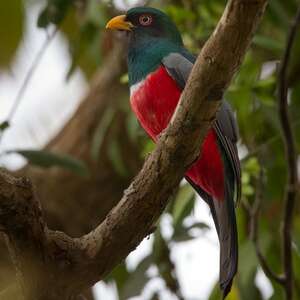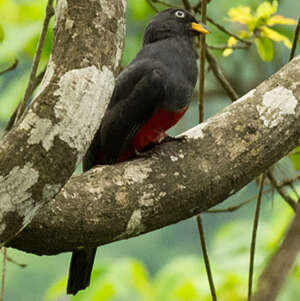Ecuadorian Trogon
Trogon mesurus - Trogon équatorien Trogon d'Équateur
Identification
The Ecuadorian Trogon (Trogon mesurus) is also considered a sub species of the Black-tailed Trogon (HBW vol.6). Its scientific name may come from the Greek word mesos meaning middle, as the equator separates the Earth in two hemispheres; the two German ornithologists Jean-Louis Cabanis (1816-1906) and Ferdinand Heine (1809-1894) may have given the bird this name in relation to its location? The description of the bird is the same as that of the Black-tailed Trogon, with the difference that the iris is white in the Ecuadorian Trogon while it is brown in the Black-tailed Trogon, in both cases the eye is surrounded by a red orbital circle. The male thus has a yellow beak, black lores and throat, emerald green crown and chest, a white mark separates the chest from the red-vermillion belly. The mantle and back have the same emerald green as the crown, the upper tail feathers and the rump tending more towards the turquoise-blue. All the coverts are vermiculated with horizontal black and white lines, a characteristic of many trogons. The black primaries are marked at the margins with white lines. The lower rectrices are completely black while the upper rectrices are blue-green and outlined with a horizontal black line at the tip of the tail. The barely visible tarses are light brown. The female has a description similar to that of the female Black-tailed Trogon: yellow beak with a very marked black culmen, white iris and the absence of the orbital circle which is still visible in the female Black-tailed Trogon, the lores are almost completely black, the chest and upper part of the belly are grey, the belly is red and there is no white mark, visible in the male, separating the chest from the belly. The mantle and back are grey, the vermiculations of the coverts are barely visible, the female showing the same white margins on the primaries.The lower and upper tail feathers are completely black.
Subspecific information monotypic species
Foreign names
- Trogon équatorien,
- Trogón colinegro occidental,
- surucuá-equatoriano,
- Guayaquiltrogon,
- Ecuadoraanse Trogon,
- Trogone dell'Ecuador,
- ecuadortrogon,
- Ecuadortrogon,
- trogón ekvádorský,
- Ecuadortrogon,
- ecuadorintrogoni,
- trogon cuanegre de l'Equador,
- trogon ekwadorski,
- Белоглазый трогон,
- エクアドルキヌバネドリ,
- 厄瓜多尔咬鹃,
- ecuadortrogon,
- 厄瓜多咬鵑,
Voice song and call
The same song as the Black-tailed Trogon kwo-kwo-kwo but with a slower start that gradually increases in intensity.
Habitat
The Ecuadorian Trogon can be found in scattered forests, in both deciduous and lowland tropical trees. Generally it stays around 800 m in altitude, but it can be seen up to 2,000 m in the southwest of Ecuador. It usually prefers drier habitats than its close cousin, the White-eyed Trogon, with whom it shares its range.
Dietfeeding habits
Reproduction nesting
We have very little information on the breeding of the Ecuadorian Trogon, probably occurring from September to October, and just like the Black-tailed Trogon, it must build its nest inside an arboreal termitarium or in a big trunk excavation.
Threats - protection
IUCN conservation status
concern
in the Wild
threatened
evaluated
LC does not seem to be in danger, the Ecuadorian Trogon has adapted to various environments in its preferred country, Ecuador. The species or subspecies, depending on the source, is little known and little studied.
Sources of information
- IOC World Bird List (v15.1), Gill, F and D Donsker (Eds). 2025-12-07.
- A Natural history of the Trogonidae, Joseph M.Forshaw Albert Earl Gilbert
- Vol. 6 - Handbook of the Birds of the World, Josep del Hoyo-Andrew Elliott-Jordi Sargatal
- xeno-canto, Sharing bird sounds from around the world,
- Avibase, Lepage Denis
- BirdLife International, BirdLife International
- Neotropical Birds Online,
- Wikipédia, Wikipedia, The Free Encyclopedia
- HBW Alive,
Other sources of interest
 Specification sheet created on
04/08/2023 by Anne et Gabriel Leboff
Specification sheet created on
04/08/2023 by Anne et Gabriel LeboffTranslation by AI Oiseaux.net
© 1996-2025 Oiseaux.net
- Accipitriformes
- Aegotheliformes
- Anseriformes
- Apodiformes
- Apterygiformes
- Bucerotiformes
- Caprimulgiformes
- Cariamiformes
- Casuariiformes
- Charadriiformes
- Ciconiiformes
- Coliiformes
- Columbiformes
- Coraciiformes
- Cuculiformes
- Eurypygiformes
- Falconiformes
- Galliformes
- Gaviiformes
- Gruiformes
- Leptosomiformes
- Mesitornithiformes
- Musophagiformes
- Nyctibiiformes
- Opisthocomiformes
- Otidiformes
- Passeriformes
- Pelecaniformes
- Phaethontiformes
- Phoenicopteriformes
- Piciformes
- Podargiformes
- Podicipediformes
- Procellariiformes
- Psittaciformes
- Pterocliformes
- Rheiformes
- Sphenisciformes
- Steatornithiformes
- Strigiformes
- Struthioniformes
- Suliformes
- Tinamiformes
- Trogoniformes













